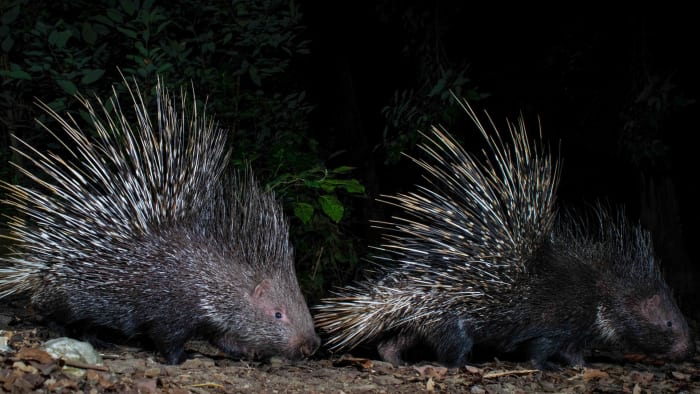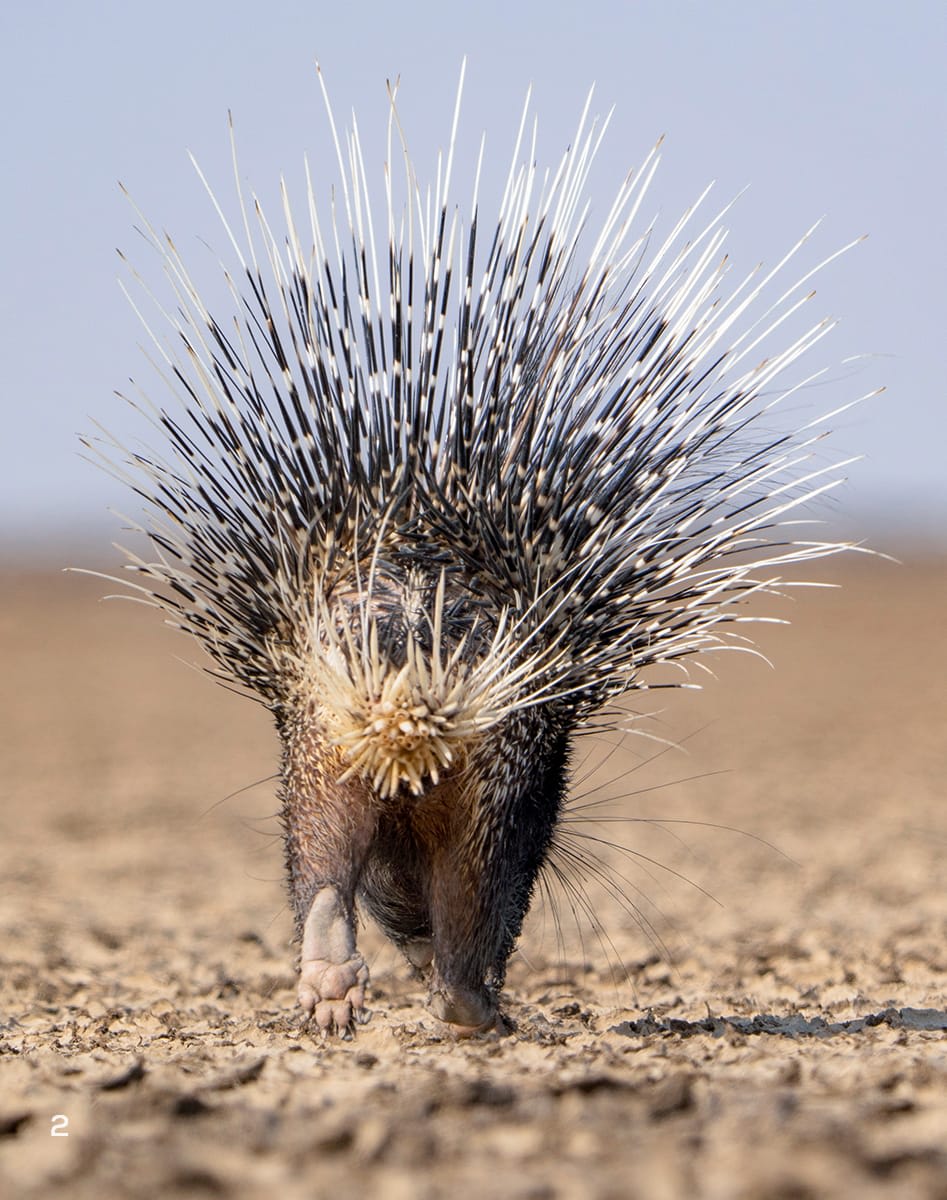 Listen to this article
•
15:34 min
Listen to this article
•
15:34 min
The Indian crested porcupine (Hystrix indica) is not a creature to get up close and personal with. This large (up to 90 cm from nose to tail), hefty, dusky brown and white rodent weighing up to 18 kg is covered with a forest of tri-coloured spines and quills, which it uses for self-defence only. The longer spines (up to 51 cm) around its neck and head are loosely attached and are controlled by muscles, and will rise menacingly when the animal feels threatened — making it look larger and more dangerous. The more deadly shorter ones arranged around its bottom and hidden behind the longer quills, are hollow and can rattle threateningly too, as the animal grunts and growls, “keep away” warnings. If the attacker is foolish enough to press home its offensive, the porcupine engages high-speed reverse gear and backs into the face of its tormenter, often leaving it with a paw-full, face-full and eye-full of quills, which slip in easily but are excruciatingly painful and difficult to remove. It is so quick that the claim has been made (falsely) that the porcupine “shoots” its quills into its victim. Many a big cat (tigers, leopards, lions, etc.) has messed with porcupines to their cost, and Jim Corbett has often mentioned how many of the man-eating tigers he shot had porcupine quills embedded in their paws and chests or had lost an eye, and hence turned to man-eating, because it was now their easiest option. Recently, there were reports of a nine-year-old tigress in Tamil Nadu that died as a result of attempting to eat a porcupine — she had quills in her face, paws, and stomach and died of starvation and probably extreme pain.
Cover photo: The Indian crested porcupine is a shy, nocturnal rodent found across rocky hillsides, scrublands, grasslands, and forests. Photo: Mayuresh Hendre
I watched several videos of confrontations between porcupines and big cats, and in most, it was quite clear that all the animal wanted was to get away back to its grubbing; it backed into its tormentor only as a last, almost desperate resort.
The quills are made of that wonder substance, keratin, the same as our hair, nails, and rhinos’ horns. I have a quill at home and am amazed at how light and flexible it is — and that it can so easily draw blood! It is banded, brown, white, and black. To be impaled by a cluster of these would not be pleasant.
The porcupine means no harm (it has friendly, beady little eyes!) — all it wants is to be able to forage on herbage (for at least 7 hours a night) — scoffing up tubers, leaves, roots, shoots, bulbs, fruit, grains et al. in peace. It has wide, spade-shaped forelegs, long claws useful for digging, a good sense of smell, and sharp incisors. It will gnaw on bones to gain trace minerals and sharpen its incisors, and may debark trees when food is scarce. It adapts to all kinds of habitats and is found all over the Indian subcontinent on rocky hillsides, shrublands, grasslands, forests, plantations, and gardens (where it can do much damage by digging up beds).
Mostly, the porcupine spends the day underground in burrows it has excavated or in caves, emerging at night to feed. Possibly afraid of predation, it even avoids bright moonlit nights, though it may briefly emerge in summer — but stays close to its den. In winter, it may indulge in a spot of sunbathing to warm up.
It is difficult to imagine porcupines on a honeymoon (ouch!), but somehow they do go on them and usually get it done between February and March. The lady will have her babies, usually a brood of two or four, born with open eyes some 240 days later. Needless to say, the babies’ spines are soft and short when they are born and harden thereafter! Scientists have suggested that charmingly, porcupine couples are monogamous and make out every night — not so much to have more babies — but (like us!) to keep their relationship strong and the family intact. The babies are weaned by 19 weeks and will stay with their parents for two years before wandering off on their own.
As for their relationship with us, it’s quite a conundrum. We have hunted porcupines for their meat and quills (which allegedly have medicinal uses), and worse, destroyed and disfigured so much of their habitat that they are coming out of what remains of their forests and habitats and are now invading our fields and destroying our crops. They are listed under “Least Concern” in the IUCN’s Red Data Book, and for long were only on Schedule IV of the Indian Wildlife (Protection) Act of 1972, but were kicked upstairs to Schedule I according to the Act amended in 2022, according them Z class security. But they have caused so much damage to the precious saffron fields in parts of Kashmir that the cultivators have been forced to shift to planting almonds and apples instead of their precious “red gold”. The animals dig up and destroy the corms of the rare, hard-to-grow plants. Down south, they have invaded coconut, bamboo, and rubber plantations, debarking and destroying the trees. Earlier, they were hunted, but now they have the protection of the law, and neither the cultivators nor authorities seem to know how to solve the problem. Restoring their original habitats could be a solution, unlikely though it may be, because once you get used to an easier (and maybe tastier) option, there is no reason to return.
As for my own relationship with them, I personally owe these innocent creatures an apology for casting them as an evil terrorist outfit, the Al- Seekh-Kabab-Atankvad Andolan, out to exterminate tigers, in one of my books!










